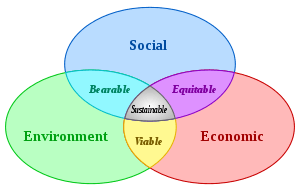Urban ecology
Urban ecology is the scientific study of the relation of living organisms with each other and their surroundings in the context of an urban environment. The urban environment refers to environments dominated by high-density residential and commercial buildings, paved surfaces, and other urban-related factors that create a unique landscape dissimilar to most previously studied environments in the field of ecology.[1] The goal of urban ecology is to achieve a balance between human culture and the natural environment.[2]

Urban ecology is a recent field of study compared to ecology as a whole. The methods and studies of urban ecology are similar to and comprise a subset of ecology. The study of urban ecology carries increasing importance because more than 50% of the world's population today lives in urban areas.[3] At the same time, it is estimated that within the next forty years, two-thirds of the world's population will be living in expanding urban centers.[4] The ecological processes in the urban environment are comparable to those outside the urban context. However, the types of urban habitats and the species that inhabit them are poorly documented. Often, explanations for phenomena examined in the urban setting as well as predicting changes because of urbanization are the center for scientific research.[1]
History

Ecology has historically focused on "pristine" natural environments, but by the 1970s many ecologists began to turn their interest towards ecological interactions taking place in, and caused by urban environments. Jean-Marie Pelt's 1977 book The Re-Naturalized Human,[5] Brian Davis' 1978 publication Urbanization and the diversity of insects,[6] and Sukopp et al.'s 1979 article "The soil, flora and vegetation of Berlin's wastelands"[7] are some of the first publications to recognize the importance of urban ecology as a separate and distinct form of ecology the same way one might see landscape ecology as different from population ecology. Forman and Godron's 1986 book Landscape Ecology[8] first distinguished urban settings and landscapes from other landscapes by dividing all landscapes into five broad types. These types were divided by the intensity of human influence ranging from pristine natural environments to urban centers.
Urban ecology is recognized as a diverse and complex concept which differs in application between North America and Europe. The European concept of urban ecology examines the biota of urban areas, while the North American concept has traditionally examined the social sciences of the urban landscape,[9] as well as the ecosystem fluxes and processes.[10]
Methods
Since urban ecology is a subfield of ecology, many of the techniques are similar to that of ecology. Ecological study techniques have been developed over centuries, but many of the techniques use for urban ecology are more recently developed. Methods used for studying urban ecology involve chemical and biochemical techniques, temperature recording, heat mapping remote sensing, and long-term ecological research sites.
Chemical and biochemical techniques
Chemical techniques may be used to determine pollutant concentrations and their effects. Tests can be as simple as dipping a manufactured test strip, as in the case of pH testing, or be more complex, as in the case of examining the spatial and temporal variation of heavy metal contamination due to industrial runoff.[11] In that particular study, livers of birds from many regions of the North Sea were ground up and mercury was extracted. Additionally, mercury bound in feathers was extracted from both live birds and from museum specimens to test for mercury levels across many decades. Through these two different measurements, researchers were able to make a complex picture of the spread of mercury due to industrial runoff both spatially and temporally.
Other chemical techniques include tests for nitrates, phosphates, sulfates, etc. which are commonly associated with urban pollutants such as fertilizer and industrial byproducts. These biochemical fluxes are studied in the atmosphere (e.g. greenhouse gasses), aquatic ecosystems and soil vegetation.[12] Broad reaching effects of these biochemical fluxes can be seen in various aspects of both the urban and surrounding rural ecosystems.
Temperature data and heat mapping
Temperature data can be used for various kinds of studies. An important aspect of temperature data is the ability to correlate temperature with various factors that may be affecting or occurring in the environment. Oftentimes, temperature data is collected long-term by the Office of Oceanic and Atmospheric Research (OAR), and made available to the scientific community through the National Oceanic and Atmospheric Administration (NOAA).[13] Data can be overlaid with maps of terrain, urban features, and other spatial areas to create heat maps. These heat maps can be used to view trends and distribution over time and space.[13][14]
Remote sensing
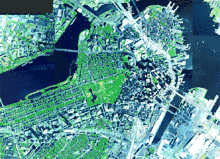
Remote sensing is the technique in which data is collected from distant locations through the use of satellite imaging, radar, and aerial photographs. In urban ecology, remote sensing is used to collect data about terrain, weather patterns, light, and vegetation. One application of remote sensing for urban ecology is to detect the productivity of an area by measuring the photosynthetic wavelengths of emitted light.[15] Satellite images can also be used to detect differences in temperature and landscape diversity to detect the effects of urbanization.[14]
LTERs and long-term data sets
Long-term ecological research (LTER) sites are research sites funded by the government that have collected reliable long-term data over an extended period of time in order to identify long-term climatic or ecological trends. These sites provide long-term temporal and spatial data such as average temperature, rainfall and other ecological processes. The main purpose of LTERs for urban ecologists is the collection of vast amounts of data over long periods of time. These long-term data sets can then be analyzed to find trends relating to the effects of the urban environment on various ecological processes, such as species diversity and abundance over time.[15] Another example is the examination of temperature trends that are accompanied with the growth of urban centers.[16]
Urban effects on the environment
Humans are the driving force behind urban ecology and influence the environment in a variety of ways, such as modifying land surfaces and waterways, introducing foreign species, and altering biogeochemical cycles. Some of these effects are more apparent, such as the reversal of the Chicago River to accommodate the growing pollution levels and trade on the river.[17] Other effects can be more gradual such as the change in global climate due to urbanization.[18]
Modification of land and waterways
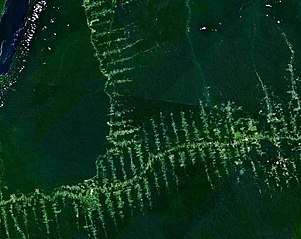
Humans place high demand on land not only to build urban centers, but also to build surrounding suburban areas for housing. Land is also allocated for agriculture to sustain the growing population of the city. Expanding cities and suburban areas necessitate corresponding deforestation to meet the land-use and resource requirements of urbanization. Key examples of this are Deforestation in the United States and Brazil.[19]
Along with manipulation of land to suit human needs, natural water resources such as rivers and streams are also modified in urban establishments. Modification can come in the form of dams, artificial canals, and even the reversal of rivers. Reversing the flow of the Chicago River is a major example of urban environmental modification.[17] Urban areas in natural desert settings often bring in water from far areas to maintain the human population and will likely have effects on the local desert climate.[15] Modification of aquatic systems in urban areas also results in decreased stream diversity and increased pollution.[20]
Trade, shipping, and spread of invasive species
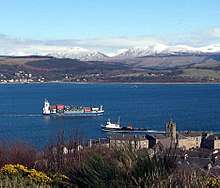

Both local shipping and long-distance trade are required to meet the resource demands important in maintaining urban areas. Carbon dioxide emissions from the transport of goods also contribute to accumulating greenhouse gases and nutrient deposits in the soil and air of urban environments.[12] In addition, shipping facilitates the unintentional spread of living organisms, and introduces them to environments that they would not naturally inhabit. Introduced or alien species are populations of organisms living in a range in which they did not naturally evolve due to intentional or inadvertent human activity. Increased transportation between urban centers furthers the incidental movement of animal and plant species. Alien species often have no natural predators and pose a substantial threat to the dynamics of existing ecological populations in the new environment where they are introduced. Such invasive species are numerous and include house sparrows, ring-necked pheasants, European starlings, brown rats, Asian carp, American bullfrogs, emerald ash borer, kudzu vines, and zebra mussels among numerous others, most notably domesticated animals.[21][22] In Australia, it has been found that removing Lantana (L. camara, an alien species) from urban greenspaces can surprisingly have negative impacts on bird diversity locally, as it provides refugia for species like the superb fairy (Malurus cyaneus) and silvereye (Zosterops lateralis), in the absence of native plant equivalents . Although, there seems to be a density threshold in which too much Lantana (thus homogeneity in vegetation cover) can lead to a decrease in bird species richness or abundance .
Human effects on biogeochemical pathways
Urbanization results in a large demand for chemical use by industry, construction, agriculture, and energy providing services. Such demands have a substantial impact on biogeochemical cycles, resulting in phenomena such as acid rain, eutrophication, and global warming.[12] Furthermore, natural biogeochemical cycles in the urban environment can be impeded due to impermeable surfaces that prevent nutrients from returning to the soil, water, and atmosphere.[23]

Demand for fertilizers to meet agricultural needs exerted by expanding urban centers can alter chemical composition of soil. Such effects often result in abnormally high concentrations of compounds including sulfur, phosphorus, nitrogen, and heavy metals. In addition, nitrogen and phosphorus used in fertilizers have caused severe problems in the form of agricultural runoff, which alters the concentration of these compounds in local rivers and streams, often resulting in adverse effects on native species.[24] A well-known effect of agricultural runoff is the phenomenon of eutrophication. When the fertilizer chemicals from agricultural runoff reach the ocean, an algal bloom results, then rapidly dies off.[24] The dead algae biomass is decomposed by bacteria that also consume large quantities of oxygen, which they obtain from the water, creating a "dead zone" without oxygen for fish or other organisms. A classic example is the dead zone in the Gulf of Mexico due to agricultural runoff into the Mississippi River.
Just as pollutants and alterations in the biogeochemical cycle alter river and ocean ecosystems, they exert likewise effects in the air. Some stems from the accumulation of chemicals and pollution and often manifests in urban settings, which has a great impact on local plants and animals. Because urban centers are often considered point sources for pollution, unsurprisingly local plants have adapted to withstand such conditions.[12]
Urban effects on climate
Urban environments and outlying areas have been found to exhibit unique local temperatures, precipitation, and other characteristic activity due to a variety of factors such as pollution and altered geochemical cycles. Some examples of the urban effects on climate are urban heat island, oasis effect, greenhouse gases, and acid rain. This further stirs the debate as to whether urban areas should be considered a unique biome. Despite common trends among all urban centers, the surrounding local environment heavily influences much of the climate. One such example of regional differences can be seen through the urban heat island and oasis effect.[16]
Urban heat island effect
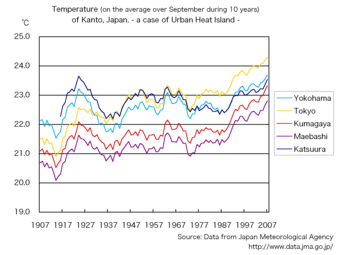
The urban heat island is a phenomenon in which central regions of urban centers exhibit higher mean temperatures than surrounding urban areas.[25] Much of this effect can be attributed to low city albedo, the reflecting power of a surface, and the increased surface area of buildings to absorb solar radiation.[16] Concrete, cement, and metal surfaces in urban areas tend to absorb heat energy rather than reflect it, contributing to higher urban temperatures. Brazel et al.[16] found that the urban heat island effect demonstrates a positive correlation with population density in the city of Baltimore. The heat island effect has corresponding ecological consequences on resident species.[12] However, this effect has only been seen in temperate climates.
Greenhouse gases
Greenhouse gas emissions include those of carbon dioxide and methane from the combustion of fossil fuels to supply energy needed by vast urban metropolises. Other greenhouse gases include water vapor, and nitrous oxide. Increases in greenhouse gases due to urban transport, construction, industry and other demands have been correlated strongly with increase in temperature. Sources of methane are agricultural dairy cows [26][27] and landfills.[28]
Acid rain and pollution
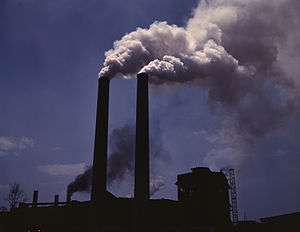
Processes related to urban areas result in the emission of numerous pollutants, which change corresponding nutrient cycles of carbon, sulfur, nitrogen, and other elements.[29] Ecosystems in and around the urban center are especially influenced by these point sources of pollution. High sulfur dioxide concentrations resulting from the industrial demands of urbanization cause rainwater to become more acidic.[30][31] Such an effect has been found to have a significant influence on locally affected populations, especially in aquatic environments.[31] Wastes from urban centers, especially large urban centers in developed nations, can drive biogeochemical cycles on a global scale.[12]
Urban environment as an anthropogenic biome
The urban environment has been classified as an anthropogenic biome,[32] which is characterized by the predominance of certain species and climate trends such as urban heat island across many urban areas.[1][8] Examples of species characteristic of many urban environments include, cats, dogs, mosquitoes, rats, flies, and pigeons, which are all generalists.[33] Many of these are dependent on human activity and have adapted accordingly to the niche created by urban centers.
Biodiversity and urbanization
Research thus far indicates that, on a small scale, urbanization often increases the biodiversity of non-native species while reducing that of native species. This normally results in an overall reduction in species richness and increase in total biomass and species abundance. Urbanization also reduces diversity on a large scale.[34]
Urban stream syndrome is a consistently observed trait of urbanization characterized by high nutrient and contaminant concentration, altered stream morphology, increased dominance of dominant species, and decreased biodiversity[20][35] The two primary causes of urban stream syndrome are storm water runoff and wastewater treatment plant effluent.[12][35]
Changes in diversity
Diversity is normally reduced at intermediate-low levels of urbanization but is always reduced at high levels of urbanization. These effects have been observed in vertebrates and invertebrates while plant species tend to increase with intermediate-low levels of urbanization[36][37] but these general trends do not apply to all organisms within those groups. For example, McKinney’s (2006)[36] review did not include the effects of urbanization on fishes and of the 58 studies on invertebrates, 52 included insects while only 10 included spiders. There is also a geographical bias as most of the studies either took place in North America or Europe.
The effects of urbanization also depend on the type and range of resources used by the organism.[34][38][39] Generalist species, those that use a wide range of resources and can thrive under a large range of living conditions, are likely survive in uniform environments. Specialist species, those that use a narrow range of resources and can only cope with a narrow range of living conditions, are unlikely to cope with uniform environments.[38] There will likely be a variable effect on these two groups of organisms as urbanization alters habitat uniformity.[36] Surprisingly, endangered plant species have been reported to occur throughout a wide range of urban ecosystems, many of them being novel ecosystems.[40]
A study of 463 bird species reported that urban species share dietary traits. Specifically, urban species were larger, consumed more vertebrates and carrion, and fed more frequently on the ground or aerially, and also had broader diets than non‐urban species.[41]
Cause of diversity change
The urban environment can decrease diversity through habitat removal and species homogenization—the increasing similarity between two previously distinct biological communities. Habitat degradation and habitat fragmentation[39] reduces the amount of suitable habitat by urban development and separates suitable patches by inhospitable terrain such as roads, neighborhoods, and open parks.[42] Although this replacement of suitable habitat with unsuitable habitat will result in extinctions of native species, some shelter may be artificially created and promote the survival of non-native species (e.g. house sparrow and house mice nests).[34] Urbanization promotes species homogenization through the extinction of native endemic species and the introduction of non-native species that already have a widespread abundance.[34] Changes to the habitat may promote both the extinction of native endemic species and the introduction of non-native species.[43] The effects of habitat change will likely be similar in all urban environments as urban environments are all built to cater to the needs of humans.[34]
The urban environment can also increase diversity in a number of ways. Many foreign organisms are introduced and dispersed naturally or artificially in urban areas. Artificial introductions may be intentional, where organisms have some form of human use, or accidental, where organisms attach themselves to transportation vehicles.[34] Humans provide food sources (e.g. birdfeeder seeds, trash, garden compost)[36] and reduce the numbers of large natural predators in urban environments,[39] allowing large populations to be supported where food and predation would normally limit the population size. There are a variety of different habitats available within the urban environment as a result of differences in land use[36] allowing for more species to be supported than by more uniform habitats.
Ways to improve urban ecology: civil engineering and sustainability
Cities should be planned and constructed in such a way that minimizes the urban effects on the surrounding environment (urban heat island, precipitation, etc.) as well as optimizing ecological activity. For example, increasing the albedo, or reflective power, of surfaces in urban areas, can minimize urban heat island,[44][45] resulting in a lower magnitude of the urban heat island effect in urban areas. By minimizing these abnormal temperature trends and others, ecological activity would likely be improved in the urban setting.[1][46]
Need for remediation
Urbanization has indeed had a profound effect on the environment, on both local and global scales. Difficulties in actively constructing habitat corridor and returning biogeochemical cycles to normal raise the question as to whether such goals are feasible. However, some groups are working to return areas of land affected by the urban landscape to a more natural state.[47] This includes using landscape architecture to model natural systems and restore rivers to pre-urban states.[47]
Species reintroduction
Reintroduction of species to urban settings can help improve the local biodiversity previously lost; however the following guidelines should be followed in order to avoid undesired effects[48][49].
- No predators capable of killing children will be reintroduced to urban areas.
- There will be no introduction of species that significantly threaten human health, pets, crops or property.
- Reintroduction will not be done when it implies significant suffering to the organisms being reintroduced, for example stress from capture or captivity.
- Organisms that carry pathogens will not be reintroduced.
- Organisms whose genes threaten the genetic pool of other organisms in the urban area will not be reintroduced.
- Organisms will only be reintroduced when scientific data support a reasonable chance of long term survival (if funds are insufficient for the long term effort, reintroduction will not be attempted).
- Reintroduced organisms will receive food supplementation and veterinary assistance as needed.
- Reintroduction will be done in both experimental and control areas to produce reliable assessments (monitoring must continue afterwards to trigger interventions if necessary).
- Reintroduction must be done in several places and repeated over several years to buffer for stochastic events.
- People in the areas affected must participate in the decision process, and will receive education to make reintroduction sustainable (but final decisions must be based on objective information gathered according to scientific standards).
Sustainability
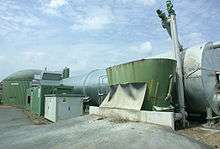
With the ever-increasing demands for resources necessitated by urbanization, recent campaigns to move toward sustainable energy and resource consumption, such as LEED certification of buildings, Energy Star certified appliances, and zero emission vehicles, have gained momentum. Sustainability reflects techniques and consumption ensuring reasonably low resource use as a component of urban ecology. Techniques such as carbon recapture may also be used to sequester carbon compounds produced in urban centers rather continually emitting more of the greenhouse gas.[50]
Urban Nature (Urban open space, Urban Greening)
On of the main methodes of improving the urban ecology is including in the cities more or less natural areas: Parks, Gardens, Lawns. These areas improve the health, the well being of the human, animal, and plant population of the cities.[51] Generally they are called Urban open space (although this word does not always mean green space), Green space, Urban greening.
A study published in Nature's Scientific Reports journal in 2019 found that people who spent at least two hours per week in nature, were 23 percent more likely to be satisfied with their life and were 59 percent more likely to be in good health than those who had zero exposure. The study used data from almost 20,000 people in the UK. The results remain the same, whether it was in one trip or multiple, and benefits increased for up to 300 minutes of exposure. The benefits applied to men and women of all ages, as well as across different ethnicities, socioeconomic status, and even those with long-term illnesses and disabilities.
People who did not get at least two hours — even if they surpassed an hour per week — did not get the benefits.
The study is the latest addition to a compelling body of evidence for the health benefits of nature. Many doctors already give nature prescriptions to their patients.
The study didn't count time spent in a person's own yard or garden as time in nature, but the majority of nature visits in the study took place within two miles from home. "Even visiting local urban green spaces seems to be a good thing," Dr. White said in a press release. "Two hours a week is hopefully a realistic target for many people, especially given that it can be spread over an entire week to get the benefit.[52]"
Summary
Urbanization results in a series of both local and far-reaching effects on biodiversity, biogeochemical cycles, hydrology, and climate, among many other stresses. Many of these effects are not fully understood, as urban ecology has only recently emerged as a scientific discipline and much more research remains to be done. Research on cities outside the US and Europe remains limited. Observations on the impact of urbanization on biodiversity and species interactions are consistent across many studies but definitive mechanisms have yet to be established. Urban ecology constitutes an important and highly relevant subfield of ecology, and further study must be pursued to more fully understand the effects of human urban areas on the environment.
See also
References
- Niemelä, Jari (1999). "Ecology and urban planning". Biodiversity and Conservation. 8 (1): 119–131. doi:10.1023/A:1008817325994.
- Caves, R. W. (2004). Encyclopedia of the City. Routledge. p. 695. ISBN 978-0415862875.
- Singh, Govind (5 October 2014). "Urban Ecology & Ecosystem Inputs – Need of the Urban Era". Urban Ecology.
- World urbanization prospects: the 2007 revision. United Nations. 2007.
- Pelt, JM (1977). L'Homme re-naturé [The man re-educated] (in French). ISBN 978-2-02-004589-6.
- Davis, BNK (1978). "Urbanisation and the diversity of insects". In Mound, L A; Walo, N (eds.). Diversity of Insect Faunas. Symposia of the Royal Entomological Society of London. 9. Oxford: Blackwell Scientific Publications. pp. 126–38.
- Sukopp, H; Blume, HP; Kunick, W (1979). "The soil, flora and vegetation of Berlin's wastelands". In Laurie, I C (ed.). Nature in Cities. Chichester: John Wiley. pp. 115–32.
- Forman, R.T.T.; Godron, M. (1986). Landscape ecology. New York: John Wiley and Sons. p. 619.
- Wittig, R.; Sukopp, H. (1993). "Was ist Stadtökologie?" [What is urban ecology?]. Stadtökologie (in German). Stuttgart: Gustav Fischer Verlag. pp. 1–9.
- Pickett, Steward T. A.; Burch Jr., William R.; Dalton, Shawn E.; Foresman, Timothy W.; Grove, J. Morgan; Rowntree, Rowan (1997). "A conceptual framework for the study of human ecosystems in urban areas". Urban Ecosystems. 1 (4): 185–199. doi:10.1023/A:1018531712889.
- Furness, R. W.; Thompson, D. R.; Becker, P. H. (March 1995). "Spatial and temporal variation in mercury contamination of seabirds in the North Sea". Helgoländer Meeresuntersuchungen. 49 (1–4): 605–615. Bibcode:1995HM.....49..605F. doi:10.1007/BF02368386.
- Grimm, N. B.; Faeth, S. H.; Golubiewski, N. E.; Redman, C. L.; Wu, J.; Bai, X.; Briggs, J. M. (8 February 2008). "Global Change and the Ecology of Cities". Science. 319 (5864): 756–760. Bibcode:2008Sci...319..756G. doi:10.1126/science.1150195. PMID 18258902.
- Gallo, K. P.; McNab, A. L.; Karl, T. R.; Brown, J. F.; Hood, J. J.; Tarpley, J. D. (May 1993). "The Use of NOAA AVHRR Data for Assessment of the Urban Heat Island Effect". Journal of Applied Meteorology. 32 (5): 899–908. doi:10.1175/1520-0450(1993)032<0899:TUONAD>2.0.CO;2.
- ROTH, M.; OKE, T. R.; EMERY, W. J. (1989). "Satellite-derived urban heat islands from three coastal cities and the utilization of such data in urban climatology". International Journal of Remote Sensing. 10 (11): 1699–1720. Bibcode:1989IJRS...10.1699R. doi:10.1080/01431168908904002.
- Shochat, E.; Stefanov, W. L.; Whitehouse, M. E. A.; Faeth, S. H. (January 2004). "Urbanization and spider diversity: influences of human modification of habitat structure and productivity". Ecological Applications. 14 (1): 268–280. doi:10.1890/02-5341.
- Brazel, A; Selover, N; Vose, R; Heisler, G (2000). "The tale of two climates-Baltimore and Phoenix urban LTER sites". Climate Research. 15: 123–135. Bibcode:2000ClRes..15..123B. doi:10.3354/cr015123.
- Hill, L. The Chicago River: A Natural and Unnatural History. Lake Claremont Press. 2000.
- Changnon, Stanley A. (May 1992). <0619:IWMIUA>2.0.CO;2 "Inadvertent Weather Modification in Urban Areas: Lessons for Global Climate Change". Bulletin of the American Meteorological Society. 73 (5): 619–627. Bibcode:1992BAMS...73..619C. doi:10.1175/1520-0477(1992)073<0619:IWMIUA>2.0.CO;2.
- Rudel, Thomas K.; Defries, Ruth; Asner, Gregory P.; Laurance, William F. (December 2009). "Changing Drivers of Deforestation and New Opportunities for Conservation". Conservation Biology. 23 (6): 1396–1405. doi:10.1111/j.1523-1739.2009.01332.x. PMID 20078640.
- Paul, Michael J.; Meyer, Judy L. (November 2001). "Streams in the Urban Landscape". Annual Review of Ecology and Systematics. 32 (1): 333–365. doi:10.1146/annurev.ecolsys.32.081501.114040.
- Ewel, John J.; O'Dowd, Dennis J.; Bergelson, Joy; Daehler, Curtis C.; D'Antonio, Carla M.; Gómez, Luis Diego; Gordon, Doria R.; Hobbs, Richard J.; Holt, Alan; Hopper, Keith R.; Hughes, Colin E.; LaHart, Marcy; Leakey, Roger R. B.; Lee, William G.; Loope, Lloyd L.; Lorence, David H.; Louda, Svata M.; Lugo, Ariel E.; McEvoy, Peter B.; Richardson, David M.; Vitousek, Peter M. (August 1999). "Deliberate Introductions of Species: Research Needs". BioScience. 49 (8): 619–630. doi:10.2307/1313438. JSTOR 1313438.
- Colautti, Robert I.; MacIsaac, Hugh J. (24 February 2004). "A neutral terminology to define 'invasive' species". Diversity and Distributions. 10 (2): 135–141. doi:10.1111/j.1366-9516.2004.00061.x.
- Kaye, J; Groffman, P; Grimm, N; Baker, L; Pouyat, R (April 2006). "A distinct urban biogeochemistry?". Trends in Ecology & Evolution. 21 (4): 192–199. doi:10.1016/j.tree.2005.12.006. PMID 16701085.
- Roach, W. John; Grimm, Nancy B. (2009). "Nutrient Variation in an Urban Lake Chain and its Consequences for Phytoplankton Production". Journal of Environmental Quality. 38 (4): 1429–40. doi:10.2134/jeq2008.0191. PMID 19465718.
- Bornstein, Robert; Lin, Qinglu (February 2000). "Urban heat islands and summertime convective thunderstorms in Atlanta: three case studies". Atmospheric Environment. 34 (3): 507–516. Bibcode:2000AtmEn..34..507B. doi:10.1016/S1352-2310(99)00374-X.
- Benchaar, C; Rivest, J; Pomar, C; Chiquette, J (1998). "Prediction of methane production from dairy cows using existing mechanistic models and regression equations". Journal of Animal Science. 76 (2): 617–27. doi:10.2527/1998.762617x. PMID 9498373.
- Moe, P.W.; Tyrrell, H.F. (October 1979). "Methane Production in Dairy Cows". Journal of Dairy Science. 62 (10): 1583–1586. doi:10.3168/jds.S0022-0302(79)83465-7.
- Daley, E. J.; Wright, I. J.; Spitzka, R. E. (1 January 1981). "Methane production from landfills. An introduction". ACS Symposium Series. 144: 279–292. doi:10.1021/bk-1981-0144.ch014. OSTI 5211185.
- Lohse, Kathleen A.; Hope, Diane; Sponseller, Ryan; Allen, Jonathan O.; Grimm, Nancy B. (25 August 2008). "Atmospheric deposition of carbon and nutrients across an arid metropolitan area". Science of the Total Environment. 402 (1): 95–105. Bibcode:2008ScTEn.402...95L. doi:10.1016/j.scitotenv.2008.04.044. PMID 18550152.
- Chen, Jie (January 2007). "Rapid urbanization in China: A real challenge to soil protection and food security". CATENA. 69 (1): 1–15. doi:10.1016/j.catena.2006.04.019.
- Singh, Anita; Agrawal, Madhoolika (January 2008). "Acid rain and its ecological consequences". Journal of Environmental Biology. 29 (1): 15–24. PMID 18831326.
- Ellis, Erle C; Ramankutty, Navin (October 2008). "Putting people in the map: anthropogenic biomes of the world". Frontiers in Ecology and the Environment. 6 (8): 439–447. doi:10.1890/070062.
- Wilby, Robert L.; Perry, George L.W. (18 August 2016). "Climate change, biodiversity and the urban environment: a critical review based on London, UK". Progress in Physical Geography: Earth and Environment. 30 (1): 73–98. doi:10.1191/0309133306pp470ra.
- McKinney, Michael L. (January 2006). "Urbanization as a major cause of biotic homogenization". Biological Conservation. 127 (3): 247–260. doi:10.1016/j.biocon.2005.09.005.
- Walsh, Christopher J.; Roy, Allison H.; Feminella, Jack W.; Cottingham, Peter D.; Groffman, Peter M.; Morgan, Raymond P. (September 2005). "The urban stream syndrome: current knowledge and the search for a cure". Journal of the North American Benthological Society. 24 (3): 706–723. doi:10.1899/04-028.1.
- McKinney, Michael L. (29 January 2008). "Effects of urbanization on species richness: A review of plants and animals". Urban Ecosystems. 11 (2): 161–176. doi:10.1007/s11252-007-0045-4.
- Marzluff, John M. (2001). "Worldwide urbanization and its effects on birds". Avian Ecology and Conservation in an Urbanizing World. pp. 19–47. doi:10.1007/978-1-4615-1531-9_2. ISBN 978-1-4613-5600-4.
- Devictor, Vincent; Julliard, Romain; Jiguet, Frédéric (11 February 2008). "Distribution of specialist and generalist species along spatial gradients of habitat disturbance and fragmentation" (PDF). Oikos: 080211051304426–0. doi:10.1111/j.2008.0030-1299.16215.x.
- Grimm, N. B.; Faeth, S. H.; Golubiewski, N. E.; Redman, C. L.; Wu, J.; Bai, X.; Briggs, J. M. (8 February 2008). "Global Change and the Ecology of Cities". Science. 319 (5864): 756–760. Bibcode:2008Sci...319..756G. doi:10.1126/science.1150195. PMID 18258902.
- Planchuelo, Greg; von Der Lippe, Moritz; Kowarik, Ingo (September 2019). "Untangling the role of urban ecosystems as habitats for endangered plant species". Landscape and Urban Planning. 189: 320–334. doi:10.1016/j.landurbplan.2019.05.007.
- Palacio, Facundo Xavier (2020). "Urban exploiters have broader dietary niches than urban avoiders". Ibis. 162 (1): 42–49. doi:10.1111/ibi.12732. ISSN 1474-919X.
- Reed, David H.; Hobbs, Gayla R. (February 2004). "The relationship between population size and temporal variability in population size". Animal Conservation. 7 (1): 1–8. doi:10.1017/S1367943004003476.
- Rahel, Frank J. (November 2002). "Homogenization of Freshwater Faunas". Annual Review of Ecology and Systematics. 33 (1): 291–315. doi:10.1146/annurev.ecolsys.33.010802.150429.
- Rosenfeld, Arthur H. "Paint the Town White--and Green". MIT Technology Review.
- Rosenfeld, Arthur H.; Akbari, Hashem; Romm, Joseph J.; Pomerantz, Melvin (August 1998). "Cool communities: strategies for heat island mitigation and smog reduction". Energy and Buildings. 28 (1): 51–62. doi:10.1016/S0378-7788(97)00063-7.
- Felson, Alexander J.; Pickett, Steward TA (December 2005). "Designed experiments: new approaches to studying urban ecosystems". Frontiers in Ecology and the Environment. 3 (10): 549–556. doi:10.1890/1540-9295(2005)003[0549:DENATS]2.0.CO;2.
- Blum, Andrew (24 November 2008). "The Long View: Urban Remediation through Landscape & Architecture". Metropolis.
- Monge-Nájera, Julián (2018-02-28). "An ethical decalogue for the reintroduction of species to urban habitats". UNED Research Journal. 10 (1). doi:10.22458/urj.v10i1.2048. ISSN 1659-441X.
- International Union for Conservation of Nature and Natural Resources. Species Survival Commission, issuing body. (2013). Guidelines for reintroductions and other conservation translocations. ISBN 978-2-8317-1609-1. OCLC 955308696.
- Nowak, David J.; Crane, Daniel E. (March 2002). "Carbon storage and sequestration by urban trees in the USA". Environmental Pollution. 116 (3): 381–389. doi:10.1016/S0269-7491(01)00214-7. PMID 11822716.
- Fuller, Richard A; Irvine, Katherine N; Devine-Wright, Patrick; Warren, Philip H; Gaston, Kevin J (22 August 2007). "Psychological benefits of greenspace increase with biodiversity". Biology Letters. 3 (4): 390–394. doi:10.1098/rsbl.2007.0149. PMC 2390667. PMID 17504734.
- Sam Nickerson, Sam (June 21, 2019). "Two Hours a Week in Nature Can Boost Your Health and Well-Being, Research Finds". Ecowatch. Retrieved 23 June 2019.

